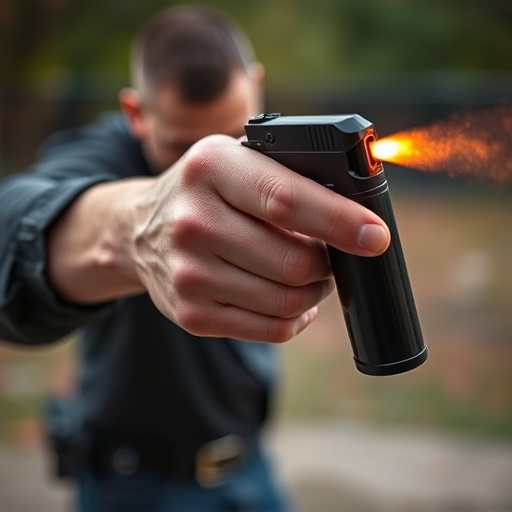When choosing between bear spray and personal pepper spray for self-defense, consider the difference in capsaicin concentration and intended use: bear spray for wildlife encounters at a distance versus personal pepper spray for close-quarters human threats. Bear spray is stronger but can harm humans if misused, while personal pepper spray has lower capsaicin content and requires closer proximity to be effective. Legalities differ widely; always check local laws regarding age limits, registration, and usage restrictions. Proper storage, safety protocols, and practice deployment techniques are crucial for maximum effectiveness and minimal risk.
“Staying safe in potentially dangerous situations is paramount, especially when it comes to self-defense. This article guides you through the essentials of using pepper spray as a powerful personal defense tool. We delve into the key differences between bear spray and personal pepper spray, offering insights for effective use in various scenarios.
Learn about safety precautions, legal considerations, and best practices to ensure responsible and effective deployment. By understanding these aspects, individuals can make informed choices regarding self-protection.”
- Understanding Bear Spray and Personal Pepper Spray: Key Differences
- When and How to Use Pepper Spray for Self-Defense
- Safety Precautions and Legal Considerations for Pepper Spray Users
Understanding Bear Spray and Personal Pepper Spray: Key Differences
When considering self-defense options, understanding the distinctions between bear spray and personal pepper spray is paramount. While both serve as potent deterrents against potential threats, their applications and effects vary significantly. Bear spray, designed for wildlife encounters, typically contains capsaicin in a much higher concentration than personal pepper spray. Its wide range and powerful impact make it effective at keeping bears at bay, but the same intensity can be overwhelming and potentially harmful if used on humans or close to the face.
Personal pepper spray, as the name suggests, is tailored for individual self-defense against people. It usually has a lower concentration of capsaicin, making it safer for use in close quarters without risking permanent damage. However, personal pepper spray’s shorter range and less potent effect may require closer proximity to the assailant. Users must be aware that bear spray and personal pepper spray are optimized for different scenarios, ensuring individuals choose the right tool according to the potential threat they face.
When and How to Use Pepper Spray for Self-Defense
When it comes to self-defense, knowing how and when to deploy pepper spray can be a lifesaver. The key is understanding that pepper spray isn’t just a last resort; it’s a powerful tool for deterring potential threats at close range. Bear spray, designed for wildlife encounters, has a much wider radius of effect but is less effective in controlled self-defense scenarios due to its aggressive nature and the risk of causing harm to bystanders. Personal pepper spray, on the other hand, is tailored for individual protection with a more focused, targeted blast.
For optimal safety and effectiveness, users should practice deployment techniques regularly. Aiming for the face—eyes, nose, and mouth—is crucial as these areas are sensitive and will temporarily disable an attacker. It’s essential to remember that pepper spray only disrupts vision and breathing temporarily; it doesn’t cause permanent damage. Users should be aware of their surroundings, ensure no bystanders are in close proximity, and consider the legal implications of its use in their jurisdiction before employing this self-defense strategy.
Safety Precautions and Legal Considerations for Pepper Spray Users
Using pepper spray as a self-defense weapon requires users to understand safety precautions and legal considerations, especially in differentiating between bear spray and personal pepper spray. Bear spray, designed for wildlife encounters, is significantly stronger than personal pepper spray, which is intended for human self-defense. Misusing bear spray can lead to severe adverse effects on the user’s health or even be illegal in certain jurisdictions.
Legal restrictions vary widely based on location, with some regions allowing only law enforcement and military personnel to carry pepper spray while others permit civilians. Users must familiarize themselves with local laws, including age restrictions and registration requirements. Additionally, safe storage and handling practices are crucial; keeping pepper spray out of reach of children and securing it in a cool, dry place will ensure its effectiveness when needed while adhering to safety protocols.
Choosing between bear spray and personal pepper spray depends on your specific needs. While bear spray offers a wider range and stronger force, personal pepper spray is more portable and designed for close-range self-defense. Regardless of choice, understanding when and how to use it safely is paramount. Always follow legal guidelines and precautions to ensure your protection without causing unnecessary harm or legal issues.
